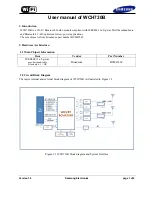
Copyright © 2004-2005, Vivato, Inc.
172
VPN
A
Virtual Private Network
(VPN) is a network that uses the Internet to connect its nodes. It uses encryption
and other mechanisms to ensure that only authorized users can access its nodes and that data cannot be
intercepted.
WAN
A
Wide Area Network
(WAN) is a communications network that spans a relatively large geographical area,
extending over distances greater than one kilometer. A WAN is often connected through public networks,
such as the telephone system. It can also be connected through leased lines or satellites.
The Internet is essentially a very large WAN.
WDS
A
Wireless Distribution System
(WDS) allows the creation of a completely wireless infrastructure. Typically,
an
. WDS allows AP/Bridges to be connected wirelessly. The AP/
Bridges can function as wireless repeaters or bridges.
WEP
Wired Equivalent Privacy
(WEP) is a data encryption protocol for
wireless networks. All wireless
stations and AP/Bridges on the network are configured with a static 64-bit (40-bit secret key + 24-bit
initialization vector (IV)) or 128-bit (104-bit secret key + 24-bit IV)
for data encryption. It uses a
stream cipher to encrypt the frame body and CRC of each
frame before transmission.
Wi-Fi
A test and certification of interoperability for
products based on the
standard promoted
by the
, a non-profit trade organization.
WINS
The
Windows Internet Naming Service
(WINS) is a server process for resolving Windows-based computer
names to IP addresses. It provides information that allows these systems to browse remote networks using
the
Network Neighborhood
.
Wireless Networking Framework
There are two ways of organizing a wireless network:
•
Stations (clients) communicate directly with one another in an
network, also known as an
independent basic service set (
•
Stations communicate through an
in an
network. A single AP/Bridge
creates an infrastructure basic service set (
) whereas multiple AP/Bridges are organized in an
extended service set (
WLAN
Wireless Local Area Network
(WLAN) is a
that uses high-frequency radio waves rather than wires to
communicate between its nodes.










































